Chavin de Huantar
22 October 2005 (Saturday) – Huaraz, Peru
Same orgy, different day.
I made friends with Julie, from Canada and David, from Italy who were also going on this tour to Chavin and the 3 of us lodged ourselves in the front seats of the bus. As the front seats are above the driver, we were not blocked by him and we actually would have a fantastic view of the mountains in front of us.
The only lamentable thing was that besides my iffy stomach, I seemed to be suffering a little from fever now and my head was throbbing painfully.
This time, instead of moving north or south along Callejon de Huaylas, we would travel eastwards through the mountain pass to get to the other side of the valley. We climbed up to 4,000m and the bus stopped briefly in front of Laguna Querococha. My headache was tremendously painful. I tottered around, not even reaching the lake and returned back to the bus to rest. Julie noticed my discomfort and gave me 2 tablets.

The bus now moved up to 4,500m to the highest point of this trip. It is not a mountain pass. It is a tunnel. But as the tunnel was being repaired or built, we were given a timeframe to pass through the mountains in order not to disturb the work. We had to be here between 12 noon and 1pm. We were there at 12 noon, but there was a long queue of tour buses and regular colectivos. Something was happening in the tunnel and no one was moving.
Due to the effects of the tablets, I drifted in and out of consciousness for nearly an hour, and each time I opened my eyes for 2 seconds, I was lucent enough to note that we were still in the same place. Finally, the buses started to move off gingerly. Once inside the tunnel, I understood why. There was a bus in there, full of passengers, but it appeared to be stuck. Hence, all the other buses had to now go around it. The road in there was atrocious.
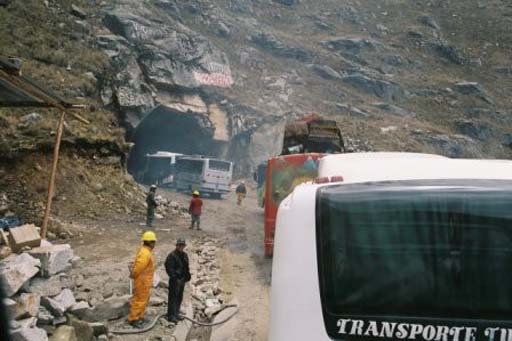
After clearing the tunnel, it was another 1 hour of spinning downhill. The effect from the drugs had worn off and I could appreciate the fantastic view by now.
We pulled up into the tiny town of Chavin and the throngs of tourists descended to lunch, before moving on to the Chavin ruins.
Chavin de Huantar is known as, up til now at least, the earliest Peruvian culture… the mother of all the pre-Columbian cultures, like the Cajamarca, Ica, Nazca cultures to the north and the south. Chavin de Huancar is a ceremonial centre, built 1,500 years before Christ. The rest of the population came walking from all over Peru to Chavin for special ceremonies.
Chavin was built near the confluence of 2 major rivers. The guide explained about the amazing drainage system built underneath the temples and the plazas, tapping water from these rivers. Water from the drains passed under the temples actually generated oxygen and gave the temples ventilation. The sound of the water was also used as special effects in the temple. However, due to landslides and earthquakes from then, over the next 3,500 years, to right about now, there is unfortunately no water through the drainage system now. But, if you think about it… everything that we walked on was not the natural ground… but there was a whole complex of rocks underneath, built in zig-zagged or whatever fashion to create the drainage systems. Gosh, it was mighty impressive.
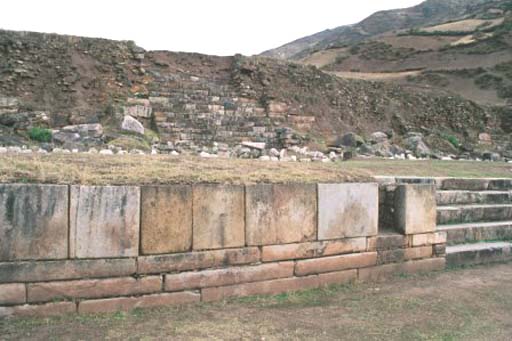
This culture, as I said, gave birth to the other early cultures of Peru and for the Cajamarca culture, remember I talked about Cumbe Mayo?, well, they had had some canals built up in the mountains… and I know the Nazca culture also built some kick-ass irrigation canals, transforming Nazca into a livable place from an otherwise inhospitable desert. How interesting for me to suddenly see the connections in these 2 other places that I had previously visited. And they all started from here in Chavin.
The culture was a peaceful culture, as none of the inscriptions uncovered were about war or trophy head decapitations or whatever. They used white and black rocks at some special steps to represent the duality of life, with male-female / good-bad / light-darkness representations.
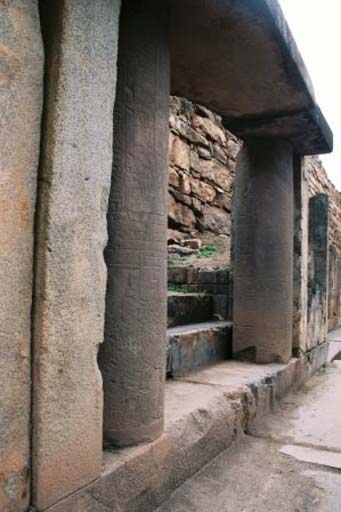
There was a rectangular block of rock with an intricate carving of the gods worshipped by the Chavins. A replica was on display for the tourists’ photo-taking. The original block was found by a farmer years ago and used as a table in his house for a long time, before Antonio Raimondi, an archaeologist, who happened to be seated at the table and his itchy fingers felt the inscriptions below the table. Then, they heaved the rock over and oohed and aahed over it, named the rock ‘La estela Raimondi‘, carried it to Lima’s archaeological museum and the poor farmer returned home to find a table missing.

The other must-see is the ‘El Lanzon monolitico’. This is a long thin piece of rock, again, intricately inscribed with all sorts of animals and motifs, lodged in the middle of a small room with 4 very narrow passageways radiating out in 4 right-angled directions. This small room is found underground and to see it, you have to enter one by one, banging your head accidentally on the low ceiling rock, and your elbow on the other rock that is jutting out at the entrance. Why is that rock jutting out at the entrance?? Oh, probably for the Chavin guards to put their ancient cans of beer as they chatted with one another. Anyway, we spent a good hour queuing up there in the drizzle, waiting our turn to get some bruises in our eagerness to view it. Very impressive work and interesting location.
There were more stone galleries for us to climb down into to walk around. They are empty and without any interestingly inscribed rocks, but what was fascinating for me was how in the world did they carry these massive rocks and lodge them in place in such an intricate criss-crossing style to build these galleries 3,500 years ago?? I also learnt these rocks came from the Laguna Querococha region. That was on the other side of the tunnel. And I am assuming in 1,500 BC, they did not have the tunnel then, since obviously, the Peruvians were still building it. So, the Chavin guys had to drag these rocks over passes way higher than 4,500m. Mind-blowing, huh?
The Chavin culture also carved some smiling faces on certain rocks jutting out of the wall. Very nice, many of them were moved to the site museum now. The Peruvian souvenir-makers meanwhile make the same smiling faces in miniature on key-chain holders for us.
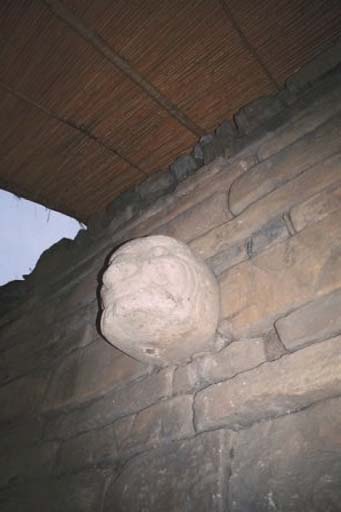
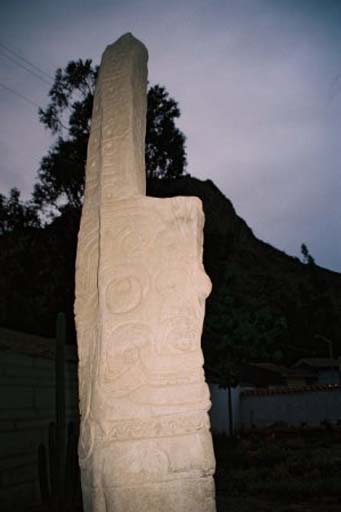
I had resisted describing to you what the teenage students were up to in the meantime. Sigh… let’s just say that the guide was nearly in tears as she screamed and yelled at them not to climb and walk on all the forbidden mounds and walls.
Two days with the same group of insolent teenagers… was just enough for me. I refused to wait for them as the poor camera man goes through 20 cameras to snap their happily posed group photo. The minute there was a fumbling, I would stride in and take the photo of the rocks. Many gave me the evil eye. I gave them mine back.
I had failed to inform you but I had said that I was all alone in my hostel, wasn’t I? Well, not anymore… yesterday morning at 5am, I woke up to the thunderous arrival of 34 students and 3 teachers in my hostel. Gosh. The hostel might have enough beds for them to sleep, but it certainly did not have enough facilities and help to service all of them and me.
When I went to take my shower last night, immediately, someone jiggled the door impatiently. “Está ocupada…” (It is occupied.) I stated the obvious. “¿Quíen es?” (Who is it?), the girl demanded to know. Huh?? Why did she need to know? It was an absolute riot last night, with the teens screaming, banging doors, yelling, singing… It was amazing I even caught some sleep… thanks to good ear-plugs. So, yes, by now, I had lost all my patience with all teenagers, ok… with all the rude teenagers.
Due to all these delays of photo-taking and the queue, we left much later than planned and we even had a tyre puncture somewhere up in the darkness and cold. It was scary, but I was too feverish to care and slept all the way back to Huaraz.
When I returned to the hostel at 10pm, I rushed into the toilet as I really had to go. Immediately, someone jiggled the door impatiently. “Está ocupada…” (It is occupied.) I stated the obvious again. “¿Quíen es?” (Who is it?), the girl demanded to know. Why in the world do you want to know who is in the toilet?!??!!? This time, I called out harshly, “¡Es Trisha!… ¡Y todavía está ocupada!” (It is Trisha!… And it is still occupied!) and took my time in there.
Tags: 08) Touch of Peru, Huaraz
